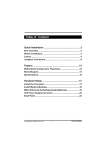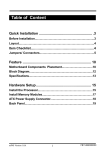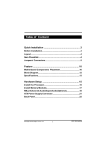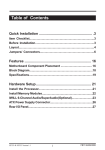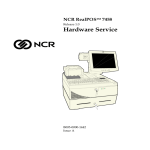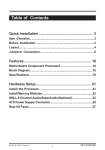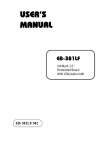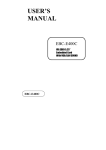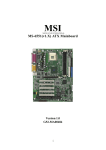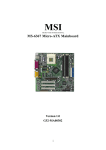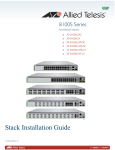Download MSI MS-6391 Instruction manual
Transcript
MSI MICRO-STAR INTERNATIONAL MD-3000 Micro ATX Mainboard Version 1.0 i Manual Rev: 1.0 Release Date: Dec. 2001 FCC-B Radio Frequency Interference Statement This equipment has been tested and found to comply with the limits for a class B digital device, pursuant to part 15 of the FCC rules. These limits are designed to provide reasonable protection against harmful interference when the equipment is operated in a commercial environment. This equipment generates, uses and can radiate radio frequency energy and, if not installed and used in accordance with the instruction manual, may cause harmful interference to radio communications. Operation of this equipment in a residential area is likely to cause harmful interference, in which case the user will be required to correct the interference at his own expense. Notice 1 The changes or modifications not expressly approved by the party responsible for compliance could void the user’s authority to operate the equipment. Notice 2 Shielded interface cables and A.C. power cord, if any, must be used in order to comply with the emission limits. VOIR LA NOTICE D’INSTALLATION AVANT DE RACCORDER AU RESEAU. Micro-Star International MD-3000 Tested to comply with FCC Standard For Home or Office Use ii Edition Dec. 2001 Copyright Notice The material in this document is the intellectual property of MICRO-STAR INTERNATIONAL. We take every care in the preparation of this document, but no guarantee is given as to the correctness of its contents. Our products are under continual improvement and we reserve the right to make changes without notice. Trademarks All trademarks are the properties of their respective owners. AMD, Athlon and Duron are registered trademarks of AMD Corporation. PS/2 and OS®/2 are registered trademarks of International Business Machines Corporation. Windows® 95/98/2000/NT/ME/XP are registered trademarks of Microsoft Corporation. Netware® is a registered trademark of Novell, Inc. Award® is a registered trademark of Phoenix Technologies Ltd. AMI® is a registered trademark of American Megatrends Inc. Revision History Revision Revision History iii Date Safety Instructions 1. 2. 3. 4. 5. Always read the safety instructions carefully. Keep this User’s Manual for future reference. Keep this equipment away from humidity. Lay this equipment on a reliable flat surface before setting it up. The openings on the enclosure are for air convection hence protects the equipment from overheating. DO NOT COVER THE OPENINGS. 6. Make sure the voltage of the power source and adjust properly 110/220V before connecting the equipment to the power inlet. 7. Place the power cord such a way that people can not step on it. Do not place anything over the power cord. 8. Always Unplug the Power Cord before inserting any add-on card or module. 9. All cautions and warnings on the equipment should be noted. 10. Never pour any liquid into the opening that could damage or cause electrical shock. 11. If any of the following situations arises, get the equipment checked by a service personnel: ! The power cord or plug is damaged ! Liquid has penetrated into the equipment ! The equipment has been exposed to moisture ! The equipment has not work well or you can not get it work according to User’s Manual. ! The equipment has dropped and damaged ! If the equipment has obvious sign of breakage 12. DO NOT LEAVE THIS EQUIPMENT IN AN ENVIRONMENT UNCONDITIONED, STORAGE TEMPERATURE ABOVE 600 C (1400F), IT MAY DAMAGE THE EQUIPMENT. CAUTION: Danger of explosion if battery is incorrectly replaced. Replace only with the same or equivalent type recommended by the manufacturer. iv CONTENTS Chapter 1. Getting Started ........................................................................ 1-1 Mainboard Specification ...................................................................... 1-2 Mainboard Layout ............................................................................... 1-4 Chapter 2. Hardware Setup ....................................................................... 2-1 Central Processing Unit: CPU .............................................................. 2-2 CPU Installation Procedures ......................................................... 2-2 CPU Core Speed Derivation Procedure ......................................... 2-3 Memory ................................................................................................ 2-4 Introduction to SDRAM ............................................................... 2-4 DIMM Module Combination ......................................................... 2-5 Installing DIMM Modules ............................................................ 2-5 Power Supply ....................................................................................... 2-6 ATX 20-Pin Power Connector ....................................................... 2-6 ATX 12V Power Connector: JPW1 ................................................ 2-6 Back Panel ............................................................................................ 2-7 Mouse Connector: JKBMS1 ......................................................... 2-7 Keyboard Connector: JKBMS1 ..................................................... 2-8 USB Connectors ............................................................................ 2-8 LAN (RJ-45) Jack ........................................................................... 2-9 Serial Port Connector: COM A & COM B1 .................................... 2-9 Joystick/Midi Connectors ........................................................... 2-10 Audio Port Connectors ............................................................... 2-10 SPDIF Connectors ....................................................................... 2-10 Parallel Port Connector: LPT1 ...................................................... 2-11 Connectors ......................................................................................... 2-12 Floppy Disk Drive Connector: FDD1 ........................................... 2-12 Hard Disk Connectors: IDE1 & IDE2 ........................................... 2-13 CD-In Connector: CD_IN1 .......................................................... 2-14 Front Audio Line-out Connector: JAUDIO1 ............................... 2-14 v Fan Power Connectors: C_FAN1 ................................................. 2-15 Front Panel Connector: FP_1 ....................................................... 2-16 Front USB Connector: USB1 ....................................................... 2-17 SPDIF Bracket Jumper: JSPDIF1 .................................................. 2-18 Jumpers .............................................................................................. 2-19 Clear CMOS Jumper: JBAT1 ........................................................ 2-19 LAN Enable/Disable Jumper: JLAN1 ........................................... 2-20 Center/Bass Setting Jumper: J11 & J12 ........................................ 2-21 Slots ................................................................................................... 2-22 AGP (Accelerated Graphics Port) Slot ......................................... 2-22 PCI Slots ...................................................................................... 2-22 PCI Interrupt Request Routing .................................................... 2-23 Appendix A: Using SPDIF & 4-/6-channel Audio Function ..................... A-1 vi Getting Started Chapter 1. Getting Started Getting Started 1 Congratulations on purchasing the MSI mainboard. MD-3000 Micro ATX mainboard is an excellent computer mainboard based on the innovative Intel® Brookdale and ICH2 chipset, which supports the Intel® Pentium 4 processor and provides you with a cost-effective solution. TOPICS Mainboard Specification Mainboard Layout MSI Special Features 1-1 1-2 1-5 1-6 Chapter 1 Mainboard Specification CPU Support Socket478 for Intel® Pentium 4(FC-PGA2) processor Support 1.3GHz, 1.4GHz and up to 2.XGHz Chipset Intel® Brookdale chipset - AGP 4x/2x universal slot - Support 100MHz FSB - Support 400MHz Intel NetBurst micro-architecture bus. Intel® ICH2 chipset (360 BGA) - AC’97 Controller integrated - 2 full IDE channels, up to ATA100 - Integrated 10/100Mbit/sec Etherent - Low pin count interface for Winbond SIO Main Memory (This section refers only to S-DRAM Layout) Support two 168-pin DIMM sockets Support a 32 to 1GB memory using 512Mbit technology Max. memory size: 2GB Slots One AGP (Accelerated Graphics Port) 2x/4x slot Two PCI 2.2 32-bit Master PCI Bus slots, the third PCI can support 2 Master devices Support 3.3v/5v PCI bus interface On-boardIDE An IDE controller on the ICH2 chipset provides IDE HDD/CD-ROM with PIO, Bus Master and Ultra DMA 66/ 100 operation modes Can connect to four IDE devices 1-2 Getting Started On-board Peripherals One floppy port that supports two FDD with 360KB, 720KB, 1.44MB and 2.88MB Two serial ports (COM A/ Reserved in pin header) One parallel port that supports SPP/EPP/ECP modes Four USB ports (2 rear connectors and 2 USB front pin header) One RJ-45 connector One Line-In/ 3 Line-Out/Game port Network Realtek 8100 single chip fast 10/100 Mb/s Ethernet controller ACPI, APM supported H/W Audio (option) C-media CMI8738-6CH-MX Support 6 channel audio AC’97 2.1 compliant Support SPDIF BIOS The mainboard BIOS provides “Plug & Play” BIOS that can detect the periph-eral devices and expansion cards installed on the board automatically Support Desktop Management Interface (DMI) function that can record your mainboard specifications Dimension Micro ATX Form Factor (24.4cm x 22.4cm) Mounting 6 mounting holes 1-3 Chapter 1 Mainboard Layout JPW1 Top: LAN Jack Bottom: USB ports C_FAN1 FDD1 ATX Power Supply Top : mouse Bottom: keyboard Bottom: Line-Out Line-In CD_IN1 Mic IDE 2 Intel Brookdale Chipset Top : Game port IDE 1 COM B1 DIMM 1 Bottom: COM A SPDIF IN/OUT DIMM 2 Top : Parallel Port Winbond W83627HF-AW AGP Slot JLAN1 C-media CMI8738 JSPDIF1 BATT + RTL 8100L PCI Slot 1 ICH2 FP_1 PCI Slot 2 USB1 FWH JAUDIO1 PCI Slot 3 JBAT1 J11 J12 MD-3000 Micro ATX Mainboard 1-4 Hardware Setup Chapter 2. Hardware Setup Hardware Setup 2 This chapter provides you with the information about hardware setup procedures. While doing the installation, be careful in holding the components and follow the installation procedures. For some components, if you install in the wrong orientation, the components will not work properly. Use a grounded wrist strap before handling computer components. Static electricity may damage the components. TOPICS Central Processing Unit: CPU Memory Power Supply Back Panel Connectors Jumpers Slots 2-1 2-2 2-5 2-7 2-8 2-13 2-20 2-23 Chapter 2 Central Processing Unit: CPU The mainboard supports Intel® Pentium® 4 processor in the 478 pin package. The mainboard uses a CPU socket called PGA478 for easy CPU installation. When you are installing the CPU, make sure the CPU has a heat sink and a cooling fan attached on the top to prevent overheating. If you do not find the heat sink and cooling fan, contact your dealer to purchase and install them before turning on the computer. Open Lever CPU Installation Procedures 1. Pull the lever sideways away Sliding Plate from the socket. Then, raise the lever up to a 90-degree angle. 2. Look for the dot/cut edge. The Dot / Cut edge dot/cut edge should point towards the lever pivot. The CPU will only fit in the correct orientation. Close Lever 3. Hold the CPU down firmly, and then close the lever to complete the installation. WARNING! Overheating will seriously damage the CPU and system, always make sure the cooling fan can work properly to protect the CPU from overheating. 2-2 Hardware Setup CPU Core Speed Derivation Procedure If CPU Clock Core/Bus ratio then CPU core speed WARNING! = = = = = 100MHz 14 Host Clock x Core/Bus ratio 100MHz x 14 1.4GHz Overclocking This motherboard is designed to support overclocking. However, please make sure your components are able to tolerate such abnormal setting, while doing overclocking. Any attempt to operate beyond product specifications is not recommended. We do not guarantee the damages or risks caused by inadequate operation or beyond product specifications. 2-3 Chapter 2 Memory (This section describes only S-DRAM The mainboard provides 2 slots for 168-pin, 3.3V SDRAM DIMM with 4 memory banks. You can install PC133/PC100 SDRAM modules on the DIMM slots (DIMM 1~2). Advice: DDR Modules have only one notch! DIMM Slots (DIMM 1~2) Introduction to SDRAM Synchronous DRAM (SDRAM) is a type of dynamic RAM memory chip that has been widely used starting in the latter part of the 1990s. SDRAMs are based on standard dynamic RAM chips, but have sophisticated features that make them considerably faster. First, SDRAM chips are fast enough to be synchronized with the CPU's clock, which eliminates wait states. Second, the SDRAM chip is divided into two cell blocks, and data is interleaved between the two so that while a bit in one block is being accessed, the bit in the other is being prepared for access. This allows SDRAM to burst the second and subsequent, contiguous characters at a rate of 10ns, compared to 60ns for the first character. SDRAM provides 800 MBps or 1 GBps data transfer depending on whether the bus is 100MHz or 133MHz. 2-4 Hardware Setup DIMM Module Combination To operate properly, at least one DIMM module must be installed. Memory modules can be installed on the slots in any order. You can install either singleor double-sided modules to meet your own needs. Memory modules can be installed in any combination as follows: Slot Memory Module Total Memory DIMM 1 (Bank 0 & Bank 1) DIMM 2 (Bank 2 & Bank 3) S/D 32MB~1GB S/D 32MB~1GB Maximum System Memory Supported S: Single Side 32MB~2GB D: Double Side Installing DIMM Modules The DIMM slot has 2 Notch Keys “VOLT and DRAM”. The module will only fit in the right orientation. 1. Insert the DIMM memory module vertically into the DIMM slot. Then push it in. DRAM notch VOLT notch 2. The plastic clip at each side of the DIMM slot will automatically close. 2-5 Chapter 2 Power Supply The mainboard supports ATX power supply for the power system. Before inserting the power supply connector, always make sure that all components are installed properly to ensure that no damage will be caused. ATX 20-Pin Power Connector This connector allows you to connect to an ATX power supply. To connect to the ATX power supply, make sure the plug of the power supply is inserted in the proper orientation and the pins are aligned. Then push down the power supply firmly into the connector. ATX 12V Power Connector: JPW1 This 12V power connector is used to provide power to the CPU. JPW1 4 3 2 1 10 20 1 11 ATX Power Supply Pin Definition JPW1 Pin Definition PIN SIGNAL 1 2 3 4 GND GND 12V 12V PIN SIGNAL PIN SIGNAL 1 2 3 4 5 6 7 8 9 3.3V 3.3V GND 5V GND 5V GND PW_OK 5V_SB 10 12V 11 12 13 14 15 16 17 18 19 20 3.3V -12V GND PS_ON GND GND GND -5V 5V 5V 2-6 Hardware Setup Back Panel The Back Panel provides the following connectors: Midi/Joystick Parallel LAN Mouse Keyboard USB SPDIF SPDIF Line-in IN OUT COM A Center / Bass (2 Channel output speaker) Line-out (Rear) (2 Channel output speaker) Line-out (Front) (2 Channel output speaker) Mouse Connector: JKBMS1 The mainboard provides a standard PS/2® mouse mini DIN connector for attaching a PS/2 ® mouse. You can plug a PS/2® mouse directly into this connector. The connector location and pin assignments are as follows: Pin Definition 6 5 3 4 2 1 PS/2 Mouse (6-pin Female) PIN SIGNAL DESCRIPTION 1 2 3 4 5 6 Mouse DATA NC GND VCC Mouse Clock NC Mouse DATA No connection Ground +5V Mouse clock No connection 2-7 Chapter 2 Keyboard Connector: JKBMS1 The mainboard provides a standard PS/2® keyboard mini DIN connector for attaching a PS/2® keyboard. You can plug a PS/2® keyboard directly into this connector. Pin Definition 6 5 3 4 1 2 PS/2 Keyboard (6-pin Female) PIN SIGNAL DESCRIPTION 1 2 3 4 5 6 Keyboard DATA NC GND VCC Keyboard Clock NC Keyboard DATA No connection Ground +5V Keyboard clock No connection USB Connectors The mainboard provides a UHCI (Universal Host Controller Interface) Universal Serial Bus root for attaching USB devices such as keyboard, mouse or other USB-compatible devices. You can plug the USB device directly into the connector. USB Port Description 1 2 3 4 5 6 7 8 USB Ports PIN SIGNAL DESCRIPTION 1 2 3 4 5 6 7 8 VCC -Data 0 +Data0 GND VCC -Data 1 +Data 1 GND +5V Negative Data Channel 0 Positive Data Channel 0 Ground +5V Negative Data Channel 1 Positive Data Channel 1 Ground 2-8 Hardware Setup LAN (RJ-45) Jack The mainboard provides one standard RJ-45 jack for connection to Local Area Network (LAN). You can connect a network cable to the LAN jack. Pin Definition PIN SIGNAL DESCRIPTION 1 TDP Transmit Differential Pair 2 TDN Transmit Differential Pair 3 RDP Receive Differential Pair 4 NC Not Used 5 NC Not Used 6 RDN Receive Differential Pair 7 NC Not Used 8 NC Not Used Serial Port Connector: COM A & COM B1 The mainboard offers two 9-pin male DIN connectors for serial port COM A and COM B1. The ports are 16550A high speed communication ports that send/receive 16 bytes FIFOs. You can attach a serial mouse or other serial devices directly to them. COM A Pin Definition 1 2 3 4 6 7 8 9 9-Pin Male DIN Connectors COM B1 1 2 3 4 5 PIN SIGNAL DESCRIPTION 1 2 3 4 5 6 7 8 9 DCD SIN SOUT DTR GND DSR RTS CTS RI Data Carry Detect Serial In or Receive Data Serial Out or Transmit Data Data Terminal Ready) Ground Data Set Ready Request To Send Clear To Send Ring Indicate 6 7 8 9 2-9 Chapter 2 Joystick/Midi Connectors You can connect a joystick or game pad to this connector. Audio Port Connectors Line In is used for external CD player, Tape player, or other audio devices. Line Out are connectors for Speakers or Headphones. Center/Bass is a connector for audio device which is used as a center speaker or supports bass effect. Line-in Center / Bass (2 Channel output speaker) Note: Details on the application of 6-channel audio can be acquired in Appendix A. Line-out (Rear) (2 Channel output speaker) Line-out (Front) (2 Channel output speaker) SPDIF Connectors The SPDIF connectors privided on the back pannel can be used to connect your digital audio equipment. SPDIF IN SPDIF OUT Note: Details on the application of 6-channel audio can be acquired in Appendix A. 2-10 Hardware Setup Parallel Port Connector: LPT1 The mainboard provides a 25-pin female centronic connector for LPT. A parallel port is a standard printer port that supports Enhanced Parallel Port (EPP) and Extended Capabilities Parallel Port (ECP) mode. 13 1 14 25 Pin Definition PIN SIGNAL DESCRIPTION 1 2 3 4 5 6 7 8 9 10 11 12 13 14 15 16 17 18 19 20 21 22 23 24 25 STROBE DATA0 DATA1 DATA2 DATA3 DATA4 DATA5 DATA6 DATA7 ACK# BUSY PE SELECT AUTO FEED# ERR# INIT# SLIN# GND GND GND GND GND GND GND GND Strobe Data0 Data1 Data2 Data3 Data4 Data5 Data6 Data7 Acknowledge Busy Paper End Select Automatic Feed Error Initialize Printer Select In Ground Ground Ground Ground Ground Ground Ground Ground 2-11 Chapter 2 Connectors The mainboard provides connectors to connect to FDD, IDE HDD, case, LAN, USB Ports, and CPU/System FAN. Floppy Disk Drive Connector: FDD1 The mainboard provides a standard floppy disk drive connector that supports 360K, 720K, 1.2M, 1.44M and 2.88M floppy disk types. FDD1 2-12 Hardware Setup Hard Disk Connectors: IDE1 & IDE2 The mainboard has a 32-bit Enhanced PCI IDE and Ultra DMA 33/66/100 controller that provides PIO mode 0~4, Bus Master, and Ultra DMA/33/66/100 function. You can connect up to four hard disk drives, CD-ROM, 120MB Floppy (reserved for future BIOS) and other devices. These connectors support the provided IDE hard disk cable. IDE2 IDE1 IDE1 (Primary IDE Connector) The first hard drive should always be connected to IDE1. IDE1 can connect a Master and a Slave drive. You must configure second hard drive to Slave mode by setting the jumper accordingly. IDE2 (Secondary IDE Connector) IDE2 can also connect a Master and a Slave drive. TIP: If you install two hard disks on cable, you must configure the second drive to Slave mode by setting its jumper. Refer to the hard disk documentation supplied by hard disk vendors for jumper setting instructions. 2-13 Chapter 2 CD-In Connector: CD_IN1 The connector is for CD-ROM audio connector. Front Audio Line-out Connector: JAUDIO1 The connector is for front audio output devices. CD_IN1 R GND L JAUDIO1 AUXL MIC GND AUXR 2-14 Hardware Setup Fan Power Connectors: C_FAN1 The C_FAN1 (processor fan) supports system cooling fan with +12V. It supports three-pin head connector. When connecting the wire to the connectors, always take note that the red wire is the positive and should be connected to the +12V, the black wire is Ground and should be connected to GND. If the mainboard has a System Hardware Monitor chipset on-board, you must use a specially designed fan with speed sensor to take advantage of the CPU fan control. SENSOR +12V GND C_FAN1 Note: 1. Always consult the vendor for proper CPU cooling fan. 2. CPU Fan supports the fan control. You can install the PC Alert utility that will automatically control the CPU Fan speed according to the actual CPU temeperature. 2-15 Chapter 2 Front Panel Connectors: FP_1 The case connector block FP_1 allows you to connect to the Power Switch, Reser Switch, Speaker, Power LED, and HDD LED on the case. FP_1 Power Switch Power LED HDD LED Reset Switch 2-16 Hardware Setup Front USB Connector: USB1 The mainboard provides a front Universal Serial Bus connector for users to connect to USB port. USB1 USB1 Pin Definition Pin Description Pin Description 1 USBPWR 2 GND 3 USBDT2- 4 GND 5 USBDT2+ 6 USBDT3+ 7 GND 8 USBDT3- 9 GND 10 USBPWR 2-17 10 9 2 1 Chapter 2 SPDIF Bracket Jumper: JSPDIF1 The mainboard comes with a jumper for users to connect an optional bracket for SPDIF output and input. JSPDIF1 7 1 8 2 JSPDIF1 Pin Definition Pin Description Pin Description 1 +12V 2 NC 3 NC 4 SPDIFO 5 SPDIFI 6 GND 7 SPDIF2 8 SPGPIO 2-18 Hardware Setup Jumpers The motherboard provides the following jumpers for you to set the computer’s function. This section will explain how to change your motherboard’s function through the use of these jumpers. Clear CMOS Jumper: JBAT1 There is a CMOS RAM on board that has a power supply from external battery to keep the data of system configuration. With the CMOS RAM, the system can automatically boot OS every time it is turned on. If you want to clear the system configuration, use the JBAT1 (Clear CMOS Jumper ) to clear data. Follow the instructions below to clear the data: 1 JBAT1 WARNING! 3 3 1 1 Keep Data Clear Data You can clear CMOS by shorting 2-3 pin while the system is off. Then return to 1-2 pin position. Avoid clearing the CMOS while the system is on; it will damage the mainboard. 2-19 Chapter 2 LAN Enable/Disable Jumper: JLAN1 Use the jumper to enable or disable the onboard LAN function. Follow the instructions below to clear the data: JLAN1 1 3 3 1 1 LAN Enable LAN Disable 2-20 Hardware Setup Center/Bass Setting Jumper: J11 & J12 The mainboard comes with two Jumpers for users to set up their center or bass speaker. If you connect a pair of speakers which supports bass through the Center/Bass audio connector (refer to P.2-11), you may need to set up which speaker can output bass in order to get a better sound effect. If you merely connect a single center or bass speaker, the setting of these two jumpers will be invalid. Follow the instructions below to set up the speakers: 1 3 1 3 J11 J12 1 3 1 3 Set the center speaker to the left and woofer to the right 1 3 1 3 Set the center speaker to the right and woofer to the left 2-21 Chapter 2 Slots The motherboard provides three 32-bit Master PCI bus slots and one AGPslot. AGP Slot PCI Slots AGP (Accelerated Graphics Port) Slot The AGP slot allows you to insert the AGP graphics card. AGP is an interface specification designed for the throughput demands of 3D graphics. It introduces a 66MHz, 32-bit channel for the graphics controller to directly access main memory and provides three levels of throughputs: 1x (266Mbps), 2x (533Mbps) and 4x (1.07Gbps). PCI Slots Three PCI slots allow you to insert the expansion cards to meet your needs. When adding or removing expansion cards, make sure that you unplug the power supply first. Meanwhile, read the documentation for the expansion card to make any necessary hardware or software settings for the expansion card, such as jumpers, switches or BIOS configuration. 2-22 Hardware Setup PCI Interrupt Request Routing The IRQ, abbreviation of interrupt request line and pronounced I-R-Q, are hardware lines over which devices can send interrupt signals to the microprocessor. The PCI IRQ pins are typically connected to the PCI bus INT A# ~ INT D# pins as follows: Order 1 Order 2 Order 3 Order 4 PCI Slot 1 INT A# INT B# INT C# INT D# PCI Slot 2 INT B# INT C# INT D# INT A# PCI Slot 3 INT C# INT D# INT A# INT B# 2-23 Using SPDIF & 4-/6-channel Audio Function Appendix A: Using 4-/6-channel Audio Function Using SPDIF & 4-/6-channel Audio A Function The mainboard comes with C-Media 6-channel audio function, which allows you to attach digital audio device or 4/6 speakers for better space sound effect. The section will tell you how to activate SPDIF or 4-/6-channel audio function. TOPICS Installing C-Media Drivers Hardware Configuration Software Configuration A-1 A-2 A-2 A-3 Appendix A Installing C-Media Drivers The mainboard is able to active the audio connectors from 2-channel to 4-/6channel or the SPDIF connectors. To use the function, you need to install the C-Media drivers. To install C-Media drivers: 1. Insert the companion CD into the CD-ROM drive. The setup screen will automatically appear. 2. Click on C-Media Sound Drivers. 3. Follow the on-screen instructions to complete installation. 4. Restart the system. Note: For Windows NT4.0, you need to install the C-Media Sound Drivers manually. Hardware Configuration After installing the C-Media drivers, you can attach the speakers for 4-/6channel audio output. Always connect the speakers to the LINE OUT connectors. The SPDIF is void when 4-/6-channel audio output is active. Different connector configurations for 2-/4-/6-channel operations are listed below: 2-Channel SPDIF IN SPDIF OUT LINE IN LINE LINE LINE OUT OUT OUT (Front) (Rear) (C/Bass) 4-Channel SPDIF IN SPDIF OUT LINE IN LINE LINE LINE OUT OUT OUT (Front) (Rear) (C/Bass) 6-Channel SPDIF IN SPDIF OUT LINE IN LINE LINE LINE OUT OUT OUT (Front) (Rear) (C/Bass) A-2 In 2-channel configuration, Line In, Line Out (Front) and SPDIF connectors are active. When set to 4-channel configuration,Line In, Line Out (Front) and Line Out (Rear) connectors are active. When set to 6-channel configuration, Line In, Line Out (Front), Line Out (Rear), Line Out (C/Bass) connectors are active. Using SPDIF & 4-/6-channel Audio Function Software Configuration To have 4-/6-channel audio work, you must set appropriate configuration in the C-Media software application. To set the multi-channel configuration: 1. Click the C-Media Mixer icon from the window tray on the bottom. 2. The following screen appears. Click the indicated button. Click here 3. The “Advanced” window appears. 4. Select 5.1 for 6-channel or 4 for 4-channel audio output. 5. Click OK. A-3




































